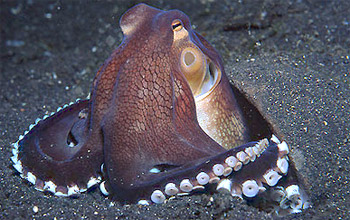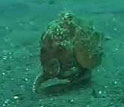News Release 05-047
Octopus Uses Two Arms to "Walk Away" from Trouble
First proof of underwater "bipedal" locomotion

Scientists report that certain octopus species use two of their eight arms to walk.
March 24, 2005
This material is available primarily for archival purposes. Telephone numbers or other contact information may be out of date; please see current contact information at media contacts.
A diving trip always reveals amazing undersea creatures, but in 2000, while helping a film crew in the waters off an Indonesian island, a University of California, Berkeley, biologist did a double take when she saw an octopus walk by on two arms! Further exploration of tropical waters revealed that at least two octopus species can raise six of their arms and walk backward on the remaining two.
Crissy Huffard, Robert Full and Farnis Barneka report this first scientific documentation of underwater "bipedal" locomotion of any animal in the March 25 issue of the journal Science.
Ordinarily, an octopus changes both its color and shape to evade predation. But when they use the familiar water propulsion to move quickly, they cannot maintain their stealth appearance. The authors postulate the two-armed behavior allows the octopus to slowly walk away from a predator while preserving its existing camouflage.
Robert Full, an animal locomotion expert, is supported through the National Science Foundation’s (NSF) Frontiers in Biological Research (FIBR) Program. Full postulates that sophisticated movements in animals are not under the control of the central nervous system. Rather, he asserts that reflexes or local nerve signals control these movements. In the case of the walking octopuses, groups of nerve cells in each arm control this sophisticated “fight-or-flight” motion.
While Crissy Huffard’s graduate work centers on the behavior of an Indonesian octopus, she recognized that her observations of the walking octopuses might help answer a different scientific question: how exactly do these animals move? This question connected her to Full, whose work emphasizes that the material properties of moving appendages strongly influence the mechanics of movement.
“One of the goals of the FIBR Program is to support the training of students who are fearless in working across disciplinary boundaries. This is an excellent case in point,” said Chris Greer, who manages the program for NSF. “Students like Crissy Huffard, who are willing and able to work across scientific boundaries, are a powerful force for removing perceived disciplinary barriers.”
Because octopuses lack bones, they do not have fixed hinges like the knees and ankles humans require for motion.Thus, they control water pressure in their soft appendages in ways that, while unknown, create remarkably complex movements. Full and Huffard continue to study this form of movement. The conclusions of the work will be extended to robotic theory, allowing the team to explore solutions for robot movement across varied or rough terrain.
-NSF-
-
View Video
Octopus marginatus uses two arms to walk across the ocean bottom.
Credit and Larger Version
Media Contacts
Richard (Randy) Vines, NSF, (703) 292-7963, email: rvines@nsf.gov
Program Contacts
Christopher L. Greer, NSF, (703) 292-8470, email: cgreer@nsf.gov
Principal Investigators
Crissy Huffard, University of California, Berkeley, (510) 643-5448, email: chuffard@berkeley.edu
Co-Investigators
Robert Full, University of California, Berkeley, (510) 642-9896, email: rjfull@socrates.berkeley.edu
The U.S. National Science Foundation propels the nation forward by advancing fundamental research in all fields of science and engineering. NSF supports research and people by providing facilities, instruments and funding to support their ingenuity and sustain the U.S. as a global leader in research and innovation. With a fiscal year 2023 budget of $9.5 billion, NSF funds reach all 50 states through grants to nearly 2,000 colleges, universities and institutions. Each year, NSF receives more than 40,000 competitive proposals and makes about 11,000 new awards. Those awards include support for cooperative research with industry, Arctic and Antarctic research and operations, and U.S. participation in international scientific efforts.
Connect with us online
NSF website: nsf.gov
NSF News: nsf.gov/news
For News Media: nsf.gov/news/newsroom
Statistics: nsf.gov/statistics/
Awards database: nsf.gov/awardsearch/
Follow us on social
Twitter: twitter.com/NSF
Facebook: facebook.com/US.NSF
Instagram: instagram.com/nsfgov



